Real Bread week: our favourite bread recipes
Apparently it’s Real Bread Maker week this week. I’m not sure why it’s not just Real Bread week, why it has to be all about breadmakers but either way, mmm bread.
When I left my last-but-one job I was given a juicer as a leaving present. As I hate juice, I swapped it for a bread maker. We probably made bread in it about a dozen times — admittedly a dozen more times than we would have used the juicer — but not enough to warrant it taking up a whole lot of space in our then-tiny kitchen. We just weren’t impressed with the bread from it – we tried a number of different recipes but none were impressive enough to be worth the effort. A few years ago, we gave the gadget to John’s sister and worked out how to make much better bread without it.
Aside from meal-centric breads like chapattis, naans and pizza dough, we tend to make three types of bread: yeast-based slow rise no knead bread, sourdough and soda bread.
Sourdough
The sourdough is by far the most labour intensive because in addition to the regular bread making stuff, we have to keep our starter alive all the time even though we don’t bake it that often. When we do make it, we use the Handmade Bakery’s “Yorkshire Leaven” and their pain de campagne recipes – the former uses a sourdough “production starter” which is left overnight before the bulk of the flour added, whereas the latter is fully mixed & kneaded then left overnight. The two different options mean we can pick the recipe which suits our schedule better – whether we have more time right then or will have more time the following day. Both result in a really tasty, substantial loaf – not like fluffy barely-there white bread from the supermarket but a real part of a meal.
Pros:
- Really, really tasty bread
- Minimal ingredients – just water, flour, a little salt & starter (which is flour & water with natural yeasts)
- Breads in theory last up to a week. Usually eaten well before that here!
Cons:
- A chore to keep the starter alive if not baked regularly
- Needs to be in a warm place during rise/proving times
- Needs to be started well in advance of eating
Slow rise no knead bread
In comparison to the sourdough, slow rise no knead bread is less flavourful – that’s not to say it’s not tasty in its own right, just it’s not so zingy. The texture is similar though – substantial with large air bubbles; you know you’re eating it, that’s for sure. It needs leaving overnight like the sourdough too but the actual involved-making time is minimal – time does the hard work so you don’t have to ;) It takes less than five minutes to mix the dough then it’s left for 12 hours or so, shaped (which takes no more than a minute), left to prove for a couple of hours then baked. And it uses only store cupboard ingredients – no pesky, needy starters. I’m willing to trade the sourdough zing for the easiness of this recipe most of the time. [Our slow rise no knead bread recipe]
Pros:
- Substantial, tasty bread
- Minimal ingredients – just water, flour, a little salt & yeast
- Takes less than five minutes to mix – no kneading! Then just a little shaping the next day before baking
- Breads in theory last up to a week. Usually eaten well before that here!
Cons:
- Needs to be started well in advance of eating
- Needs to be in a warm place during rise/proving times
- Best results using a cast iron casserole dish – can be expensive if you don’t have one
Super quick soda bread
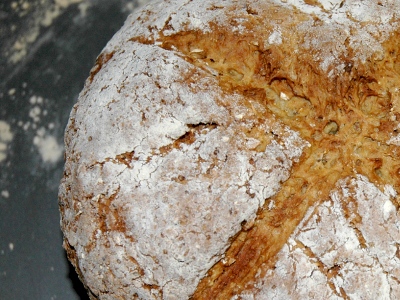
Both the sourdough and slow rise breads are great but do require a lengthy wait and need to be somewhere warm for the duration (which isn’t always possible in our house). Soda bread is our favourite “need bread now” bread as it’s ready within the hour. It doesn’t need any kneading or a warm rising/resting environment either – just mix the ingredients together and bung it in the oven. I wouldn’t go as far to say it’s an acquired taste but it certainly does have an unusual flavour – not really a bread for sandwiches but great for with a hearty winter soup or with jam for a sweet treat. [Our soda bread recipe]
Pros:
- Super quick!
- Takes less than five minutes to mix – no kneading!
- Ready to eat within the hour
- No yeast so no need to keep it warm during rising/proving
- A light crumb with a sweet, soda-y taste
Cons:
- The taste is a little unusual – delicious once you’re used to it though
- Need to have more exotic ingredients that the others (milk! ;) )
- Not as long lasting as the other breads (eat within 2 days)
So those are our three favourite real breads – what are yours? Do you bake bread regularly? Do you use a bread maker?



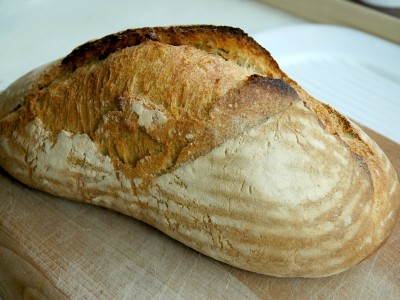
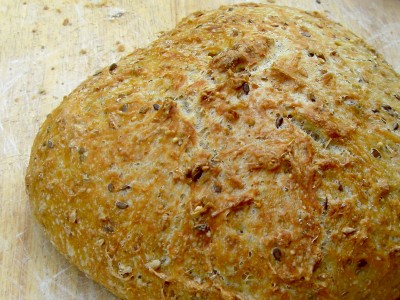
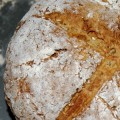

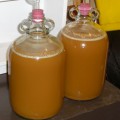

Well, Louisa, yes I use a breadmaker most of the time – but only for making the dough. All sorts of dough from basic pizzas to multigrain to semi- or light wholemeal, and so on. Once the hard work is done, out it comes and I can then knock it back, or whatever needs doing, shape it or put it in a tin or on a pizza stone, and it turns out pretty well most of the time. I’ve found from experience that my kneading was letting me down, so now I let the breadmaker do it and the effort of making real bread is much reduced. You can see from the post I did what my bread looks like now!
That’s a good idea actually – using it to do the hard work. I’m not a huge fan of kneading but get away with it when I’m doing slow rise stuff. If I was making more conventional loaves, I think I might want our breadmaker back to do that bit too! :)
You’re my inspiration, Louisa!
Seriously, making bread was just about the first thing I tried in my self sufficiency project, and I used your recipe. I now make no-knead bread every three days, still using your recipe except that I cook it in an ordinary bread tin, not a casserole, and yes, the top crust is pretty tough. I don’t find it particularly long lasting, though – by the third day it really needs toasting, but that’s OK, it makes good toast, too ;-)
Right now it’s lunch time and there’s a fresh loaf of bread cooling. It smells delicious!
Interesting that yours doesn’t last as long as ours, Rachel. I do agree it makes good toast though :)
I LOVE my bread maker. It’s the cheapest one Argos had in and it has surprisingly good features. I bought it after I read that it’s more economical to use a bread maker than to use your oven and that’s even allowing for the mixing/kneading cycle. I agree that some bread doesn’t turn out that well, but you quickly get favourite recipes. But even the bread that’s not quite as you would like it is better than the mass produced pap. Plus it’s cheaper & you know what’s in it and you can set the timer & have bread when you want it!
I don’t find sourdough particularly hard work, the feeding takes seconds, once a week & it’s very easy to time the rest of it around your schedule. I was making a sourdough loaf last week, when I got called into work, I thought it would be ruined when I got home, but it was ok, not as good as normal but not bad. Since it’s progress was delayed by 12 hours, I don’t think that’s bad going. Very forgiving stuff!
Like Albedo (hello Albedo) I use the kneading cycle on its own, specifically for my sourdough bread & pizza dough.
If you have your propagator plugged in & you can move things around a bit, it’s a great ‘warm place’ for proving bread, I use it all the time.
I haven’t yet tried the slow rise bread, but I will do soon.
I’m starting to think I’ve wronged our breadmaker! Perhaps it all came down to us not having decent recipes – we tended to follow the ones in the breadmakers’ recipe book rather than good-in-their-own-right bread recipes. If my sister-not-in-law still has it, I might get it back and give it another chance.
I could imagine the breadmaker-more-efficient-than-oven thing being true – I do try to use the oven for more than one thing at a time but don’t always manage it.
Our sourdough starter lives in the fridge but needs refreshing & feeding once a week, then needs to come out 48 hours in advance of baking and refreshed (90% thrown away and new flour/water added) a couple of times before baking. I agree it’s not a *lot* of work, but feels like a waste of flour and is more work than just using dried yeast.
I thought about using the propagator the other day for that very thing – but it’s still nursing some chilli seedlings — I’ll certainly use it for bread when the temperatures drop again.
Want to know my secret? I have a book called “The complete book of Bread & Bread Machines” by Christine Ingram & Jennie Shapter which tells you how to make breads from all around the world, with all different kinds of flour, either completely by hand, completely in a bread machine, or using the bread machine to start it and then finishing by hand. It’s very dog-eared now, with many bookmarks sticking out of it, which shows how much I refer to it. It’s absolutely brilliant & if you’re at all serious about making your own bread you need to get hold of a copy. Probably second-hand by now, try e-bay, or local charity shops, but I wouldn’t want to be without it.
Flippin ‘eck Louisa, no wonder you don’t make your sourdough bread a lot! My starter (Nigel) lives in the fridge, but only needs feeding once a week maximum. I take him out of the fridge the night before baking, feed him & in the morning ‘Bob’s your uncle’. I don’t think I could be bothered to try to remember 2 days before I needed to bake to start messing around with the starter. I only need to throw away half of the starter too, not 90%, that would feel like a waste.
Ooh, I am impressed! I don’t have a bread machine and the only bread I’ve made has been from those ‘just add water’ packs. I tend to find we don’t eat a whole frsh loaf before it goes stale but I think I might come back and try out one of your recipes next time I feel so inclined! Great post.
Albedo – thanks for the book suggestion. I’ve got a couple of bread books but I’ll keep an eye out for that one too :)
Su – heh, perhaps I should treat our Babushka meaner ;) I was following instructions from her previous caregivers. I’m also on the look out for recipes to use up the “thrown away” bit of the sourdough – do shout if you find any :)
Shoestring – Do give it a go! The idea that baking is an exact science is extremely off-putting to me but I found the slow rise one is particularly forgiving – a great entry level bread :)
I haven’t tried this, but what about sourdough pancakes? Try http://whatscookingamerica.net/Bread/SourdoughPancakes.htm for an interesting recipe (Sorry, I have no idea how to link it – waaay beyond me.
How about treating the bit of the starter you where going to throw away a bit meaner to see if it will survive?
Yep, I do think I’m molly-coddling it – I’m going treat that spare starter mean!
I tried the slow rise bread last week, it’s my favourite so far, even if I didn’t heat the cast iron casserole up hot enough! It all stuck on the bottom, I think next time I will heat the pan on the stove top to make sure it’s hot enough. And it’s so easy too!
That’s happened to us too, Su – when I thought I could skimp on the pre-heating the oven/pan. A lesson learnt!
I thought it was hot enough, but clearly I was wrong, anyway the bread was lovely. In fact when I go home (in the library now) I have another slow rise loaf to bake, can’t wait. I love bread!